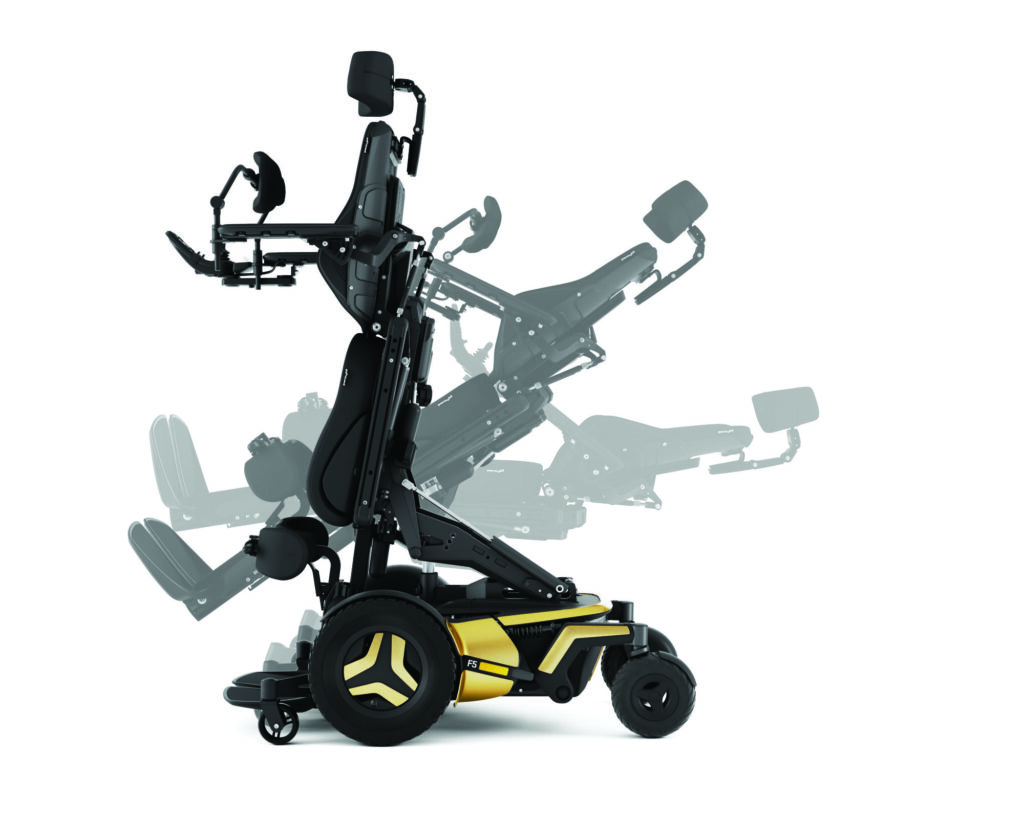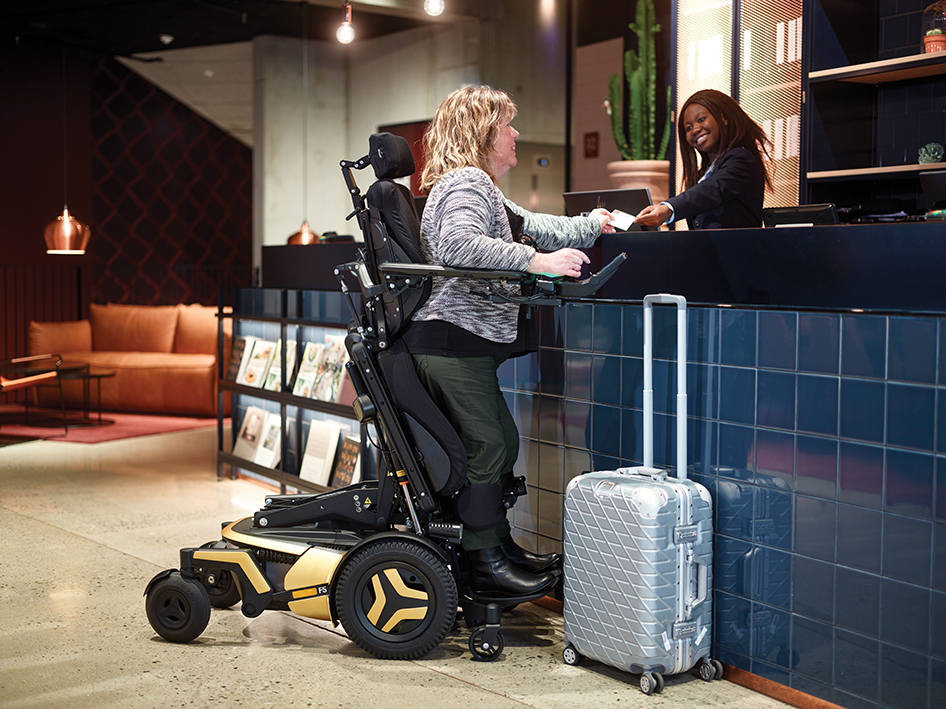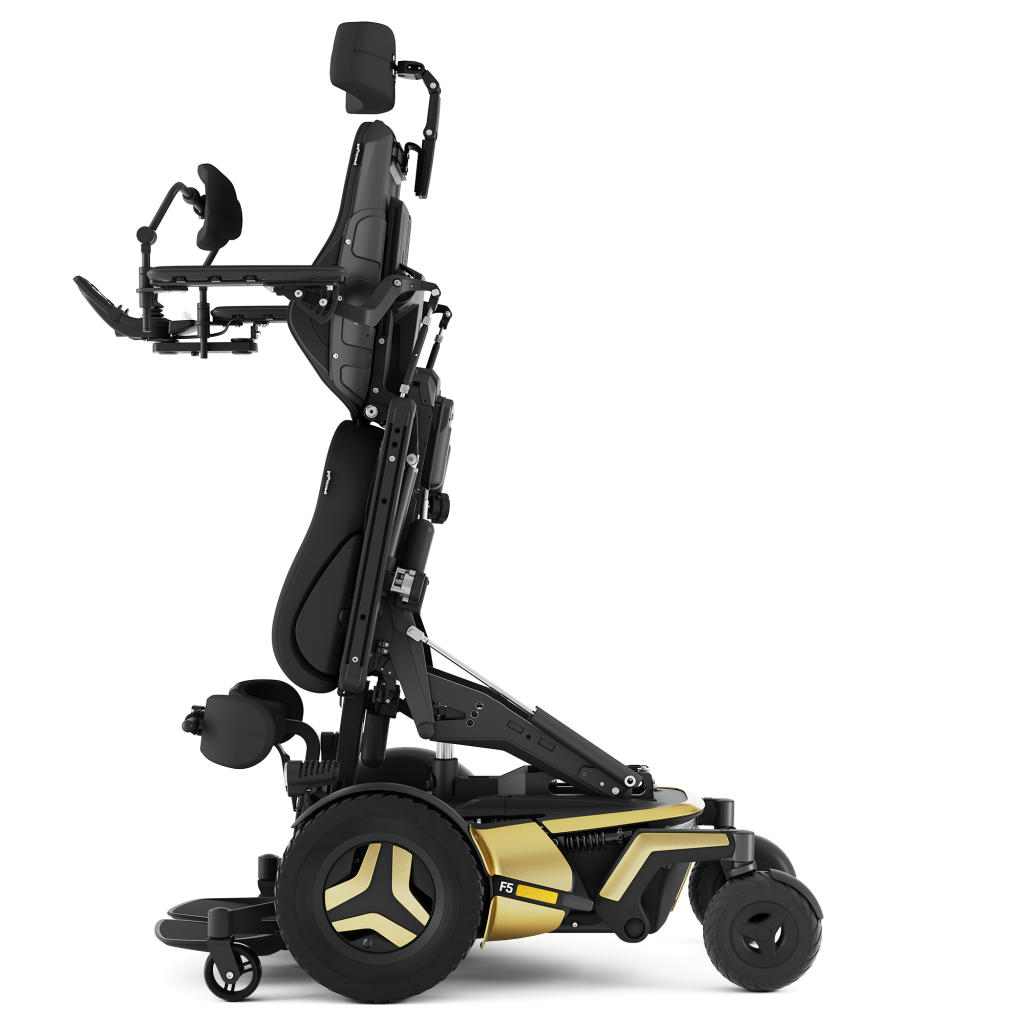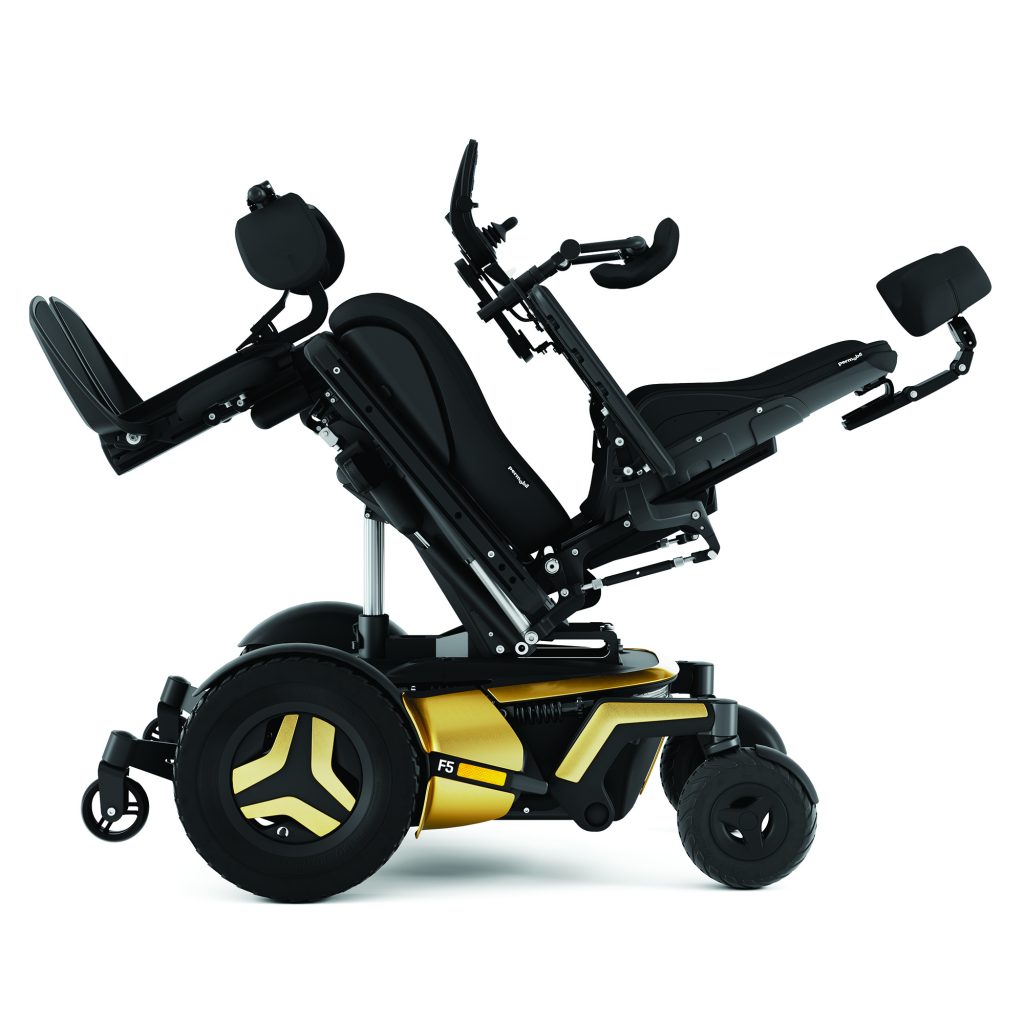Standing powerchairs: the latest insight from Recare
Recare has been at the forefront of offering specialist mobility products for over a decade. Two primary standing options are using a manual or powered base.
The powered options are the most requested route as they offer a wealth of fully adjustable seating and standing positions to configure to individual requirements. Recare provides a complete range for standing, whether you need to sit or lay to stand. Our renowned rehabilitation expertise provides Permobil, Karma Mobility or Quickie standing solutions. The manual wheelchair range can come with powered assisted seating but is not as bespoke as a fully functional powerchair.
When it comes to the benefits of standing manual and power products, it is also necessary to consider the disadvantages of being unable to. The negative impact of prolonged sitting has been researched, and the evolution towards standing desks makes this point clear for able-bodied people to prevent the adverse effects on their health.
So why is it that disabled patients are still expected to sit?
The studies show that standing with assistive technology improves physical and psychological rehabilitation outcomes. Access to this normal bodily function in a client’s rehabilitation may be due to the essential requirements to stand safely, whether in a clinical rehabilitation facility or at home without safe support. Standing technology reduces fatigue and physical burden whilst providing all the outlined benefits. Evidence shows that the benefits of standing reduce additional healthcare requirements and costs to the healthcare system.
Why is the need to stand so important?
- Allows independent weight bearing multiple times a day, essential to reducing osteoporosis, reducing the risk of joint contractures, and facilitating normal bone and joint development.
- Transfers pressure away from the scapulae, sacrum, coccyx and ischial tuberosities, reducing skin breakdown risk.
- Assists with digestion, respiration, bowel and bladder management and appropriate bladder and bowel emptying; reduces the risk of constipation and urinary tract infections.
- Improves psychosocial status and participation, allowing client increased access and independence to perform mobility-related activities of daily living.
- Provides improved compliance with the patient standing programme by having the power standing technology readily available for active, independent use while the patient is safely and securely in their everyday mobility product. This reduces the risk of harm and falls, improving continued safety for the patient and all clinicians and family assisting in daily physical therapy.
- Increases reach for functional access and make patients more productive at home, school and work. Reduces overhead reaching and the risk of a shoulder injury.
- Improves access to toilets, sinks, counters, cabinets and wardrobes, improving independence with mobility-related daily activities in the home, community or workplace.
- When slowly coming to stand from the reclined position, pausing at choice reduces the risk of orthostatic hypotension. It controls abnormal or primitive reflexes and provides spasticity management.
- Reduces depression and other psychosocial issues, enhances interaction with others and allows clients to connect face-to-face with friends, family, and peers.
- Powered standing technology allows the user to stand and drive, enhancing client mobilisation, whilst providing an effective means of pressure relief that reduces skin breakdown risk.

In 2021 Permobil, the renowned F5 Vs Corpus standing power manufacturer did a study culminating 363 studies done since 2010 to summarise the outcomes of the data available. This systematic overview looks into the clinical, functional and psychosocial benefits of standing and its effects on disabled people.
It is important to note that there is a circular correlation between these separated groups.
Clinical benefits:
- Motor ability
- Range of motion
- Spasticity
- Muscle length
- Pain
- Bowel and Bladder
- Bone mineral density
- Skin: pressure relief
Functional benefits:
- Independent mobility-related activities and daily living
- Communication
- Education
Psychological benefits:
- Mental health
- Self-esteem
- Happiness
Power standing or manual standing
There is significant research into why standing, using standing aids, is necessary for individuals’ primary rehabilitation therapy at home and clinical facilities. The typical rehabilitation static standing frame does allow people to stand. Such devices mean that clients can access the clinical and functional benefits of standing. However, to comply with their rehabilitation therapy standing plan, using these devices means clients are stuck and immobilised in one place. This reduces the likelihood of clients fulfilling all their standing therapy for the short term but, more significantly, maintaining their compliance to stand in the long term.
“79% of subjects highly recommended standing devices to people with a spinal cord injury.”
Dunn RB, Walter JS, Lucero Y, et al.
1998 The follow-up study of standing mobility device users.
A traditional standing frame requires transferring between products with or without assistance onto the stander. The study of children and their behaviour reflects the overall approach by most people towards the continuous demands of regular static standing frame use. The acceptance and utility of these standing frames at any age can become challenging to use in confined spaces and put additional risk to caregivers’ safety. As children gain independence, standing rehabilitation compliance is reduced. This demotivation escalates when they are required to physically transfer onto another piece of equipment every time they need to stand. This is reflected in adherence studies in adults, including the need to protect caregivers’ health and safety.

Standing regimes no longer need to feel like a chore, with the need to transfer, hold on to and time themselves waiting on a static frame. What happens when they aren’t having a good day, don’t feel well, or are even too tired? It feels like it requires an overwhelming challenge of effort to achieve multiple times a day. It is easier not to do it at all. The static standing frame takes up considerable room in client home environments and limits the client to only complying with their standing regime whilst they are home. This affects when they are on holiday, if they go to work, even if they spend the time socialising, in the environments, they come across daily, they have no access to standing capability.
“The difference is fewer people are involved and not getting hurt (like transferring to a standing frame or walker), it is safer and socially better, just not to have to make a scene rather than stand up.”
Anonymous
Why aren’t people standing during everyday activities in their daily lives?
The main reason, as mentioned above, is that most people don’t have integrated standing capability in their mobility products and can only stand in their home environment or with professional or caregiver support. Standing manual wheelchairs and powerchairs both have technology in design to add the biomechanical essence of standing. This inbuilt technology means the client can experience all the benefits of significant load distribution in their continuous access to assisted repositioning and pressure relief at any time. All standing devices aid the client in reducing the load on their seat and backrest. The key benefit of the modern manual and powered standing devices available today is that they no longer differentiate standing from everyday mobility. Technology today offers the user a combination of these in one product fulfilling more of the client’s rehabilitative requirements. Compliance with standing rehabilitation programs increases with it being easier for clients to integrate standing into daily activities and at home. It also benefits integrating standing into their social, economic and educational environments.
Why is the Permobil F5 VS the market-leading recommended standing powerchair?
The Permobil brand is renowned for designing advanced and long-lasting reliable powerchairs. They invest in the latest technology, research and high-quality materials to create a standing powerchair with features and benefits suitable for many clients and adapt to their personalised mobility solutions. The Permobil F5 VS has a vast range of configurability. Let us investigate deeper through some of the more unique features that make the Permobil standing powerchair the ideal standing powerchair for clients.
An integrated Intelligent Computer System (ICS) as standard on the powerchair works alongside the controller power module, operating multiple functions simultaneously, providing the smoothest, most natural biomechanics of standing from sitting to standing or to lay flat to stand. We personalised postural support to assist in moving through all of the seating positions and powerchair functions. To maintain this postural support and to ensure safety whilst standing, the powerchair has a chest support padded bar, pelvic belt (or an alternative safety belt or harness if more suitable), and secure, padded knee supports. These are the minimum essential requirements to stand securely whilst assuring safe repositioning. The consumer feedback on these standard positioning supports is available below.
The Permobil powerchair has many possible seating positions to choose from. The joystick can operate them or, as many prefer, operate the multiple functions with a switch box on hand to make changing positions significantly easier. Depending on their preference, these controls can be on either side of the client and dual to have attendant controls. Alternatively, they can be operated as attendant control only. With any of the controls, including repositioning and standing, it is not a continuous movement. Once the control is released, the chair will stop in position, and the operator of any function of the powerchair has complete control.

You may be questioning why the Permobil F5 VS (vertical standing) powerchair has standing, anterior tilt and 14″ seat lift features in one powerchair. With the capacity of the powerchair to stand, people still need choice, and often people can’t stand for as long as they would like to. If in a social environment such as at a bar with friends, standing in their powerchair engages in positive social interaction, most noticeably, clients see the change in how people engage with them more directly. They see others seeing them and making eye contact before they see their powerchair and their disability. This new feeling of inclusivity in their social environment is essential to maintain even if physically they cannot stand the whole time. This is when the powerchair’s 14″ seat lift can be used to raise the user to that same eye level, with the comfort and postural support of their choice of seating position and be able to adjust this and mobilise the powerchair.
The Permobil F5 VS has the same anterior tilt capability as the PDG Mobility Elevation manual wheelchairs. Unique advanced technology to lift the seat forwards gives more positioning options for pressure relief. Additional opportunity for boosting circulation and bone density if patients don’t always feel they can want to use the complete vertical stand (VS) capability every time. Anterior tilt does have functional benefits; the forward seat tilt and lift give patients additional height to reach cupboards and shelves. Tilting forwards offers clients reach over the front of the manual and powered wheelbase. This provides better reach as they can get closer to reaching a worktop, sink, bars, desks, kiosks and tasks such as using a cash machine. Whilst most powerchairs boast these functions using the standard seat lift, the reach and positioning support of the anterior seat tilt provides unparalleled advantages. While operating these products anterior tilt, they can also mobilise whilst in the tilt position, enabling greater manoeuvrability during mobility-related daily activities.
Suppose clients struggle with the Permobil F5 VS having the rigid padded chest bar or using the knee blocks. In that case, they give positioning postural support whilst seating, in anterior tilt and the significant safety necessity when operating the standing function. If the client doesn’t want the bars in place, they are both removable by the powerchair user whilst using the Permobil F5 VS If they are functionally able, they can equally put the two bars onto the powerchair. Many F5 VS powerchair users offer positive feedback on having the option and flexibility, giving them greater independence whilst doing everyday activities. Examples include: getting washed and changed, transferring out of the powerchair or even mobilising their upper body were able to maintain flexibility, strength and stability. One to the design of the powerchair and the way the bars slot in place securely, users report that adding and removing the support bars requires minimal grip strength. The powerchair user can adjust the knee block leg supports if needed for comfort or positioning to alter how close the knee blocks are to their lower legs. The powerchair adjustability makes it possible not to remove the support entirely to avoid needing to store them when using the powerchair in all environments.

Now you’ve learned of some great technology and advanced unique features of the Permobil F5 VS powerchair. The industry leader in biomechanical and postural vertical standing. Combined with the technology to drive and reposition the powerchair in an upright standing position. Reposition the powered wheelchair by mobilisation whilst using the 45º anterior tilt position. The powerchair technology allows one to stand vertically from the seated position and from the 180º lay flat position. Permobil powerchairs equally have the leading biomechanical and positioning in vertical standing. With the powered backrest, the powerchair seating positioning is adjustable even when lying flat. Also powered independently is the powered leg rest. Of course, the legrests have the powered elevating leg rest function. More unique is the technology to raise and lower the height of the leg rests, giving the advantage of lowering the front of the F5 VS meaning that combined with the powerchair being front-wheel drive, the client can get closer to a broader range of desks and tables.
The Permobil F5 VS is a high-cost powerchair. However, consider the vast amount of technology and features built into this market-leading impressive powerchair. This powerchair is available in an endless configurations. It takes on the integrational role of multiple products, an advanced multi-function powerchair, in their environment, saving virtual space, for example, not needing a bulgy standing frame in their home environment. Safety and reducing risk to clients and caregivers reduce the chances of needing to transfer to other equipment.
You can still have the anterior (forward) tilt integrated into the PDG Mobility Ultralight Elevation wheelchair.
Sit Right, Lay Flat, Stand Tall, and Live Life Better
As you have seen, there are many reasons for clients to add standing into their everyday lives independently. There is substantial research and development of technology available, and we have outlined many big questions. There are many more reasons why it is necessary and how technology today allows the ideal biomechanical standing function. With the combination of clinical, functional and psychosocial benefits, every client should have the opportunity to stand.
Get in touch if you aren’t sure if the client would be suitable for an everyday integrated standing mobility solution. Recare has experience with advanced complex rehabilitation consults within our team. We have various services available, including; educational demonstrations to professionals with access to standing products, joint or ourselves providing showrooms, clinics, homes, hospitals or other preferences throughout the UK. Recare is adaptable to you. For anything you have to ask, get in touch, and we will assist you in accessing and learning more. Remember, we have our Pressure Mapping equipment and significant product access. Recare is your one-stop access to a complete combined mobility and rehabilitation solution. From initial enquiry to maintenance throughout the products’ lifetime, Recare has engineering specialists, so we source, combine and create any modification or adaptation. Recare provides a genuinely personalised mobility solution to give clients access to optimal independence and fulfil their lives as much as possible. Every client can access funding support. Every client deserves the key to standing safely with their mobility solution.
Get in touch today to request your organisation, professional or client demonstration on 03303202492 or email us at info@recare.co.uk.
![Recare [logo]](https://www.recare.co.uk/wp-content/themes/recare-theme-2021/assets/img/recare-logo-no-strap.svg)
